Kenya
Kenya new banknote family (B144 - B148) confirmed introduced 31.05.2019
21 06, 2019 10:55 Category: Africa
All of these new notes bear the image of Kenyatta International Conference Centre. The banknotes also embody each of the big five: buffalo, leopard, rhinoceros, lion, and elephant. Each banknote has a unique theme to show the richness of the people and nature in Kenya (50 shillings, Green Energy; 100 shillings, Agriculture; 200 shilling, Social Services; 500 shillings, Tourism; 1,000 shillings, Governance).
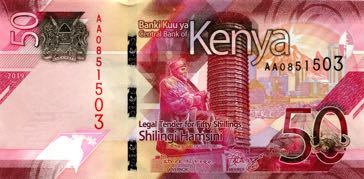



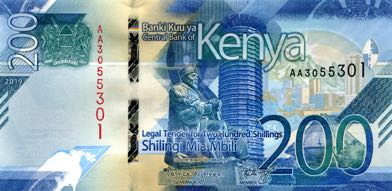
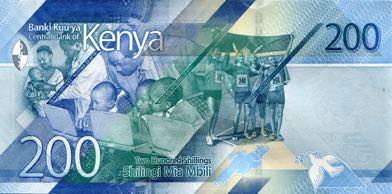




Courtesy of Numisnota (http://numisnota.eu).










Courtesy of Numisnota (http://numisnota.eu).
Kenya new notes reportedly to be introduced mid-2018
25 11, 2017 09:08 Category: Africa
According to an article dated 24 November 2017 in the Standard Digital, the Central Bank of Kenya intends to introduce new coins and banknotes by the second quarter of 2018. Plans to redesign the currency to remove portraits of real people have been in the works since 2015, but have been on hold due, in part, to a lawsuit initiated by security printer De La Rue.
Kenya new banknote family reported for introduction 29.09.2015
11 10, 2015 11:54 Category: Africa
According to an article on KBC dated 25 September 2015, on National Treasury Cabinet Secretary Henry Rotich says the government has finalized preparations for the new currency whose features would be unveiled on 29 September.
Article 231 section 4 of the Constitution prohibits the use of portraits or images of individuals on the currency and instead says notes and coins should only bear images that depict or symbolize an aspect of Kenya. Central Bank of Kenya was given until the beginning of this month to adhere to this. Rotich says despite the delay details of the new design of the local currency are now ready and would be unveiled next week.
He made the remarks during the launch of the CBK@50 celebrations, the first in a series of activities running for one year and culminating in celebrations slated for September, 2016 when CBK turns 50.
UPDATE: As of 10 October 2015, there is nothing about a new family of notes on the Central Bank of Kenya's web site.
Courtesy of Cleo Phas.
Article 231 section 4 of the Constitution prohibits the use of portraits or images of individuals on the currency and instead says notes and coins should only bear images that depict or symbolize an aspect of Kenya. Central Bank of Kenya was given until the beginning of this month to adhere to this. Rotich says despite the delay details of the new design of the local currency are now ready and would be unveiled next week.
He made the remarks during the launch of the CBK@50 celebrations, the first in a series of activities running for one year and culminating in celebrations slated for September, 2016 when CBK turns 50.
UPDATE: As of 10 October 2015, there is nothing about a new family of notes on the Central Bank of Kenya's web site.
Courtesy of Cleo Phas.
East Africa chapter of The Banknote Book is now available
17 07, 2014 17:45 Category: The Banknote Book | Africa
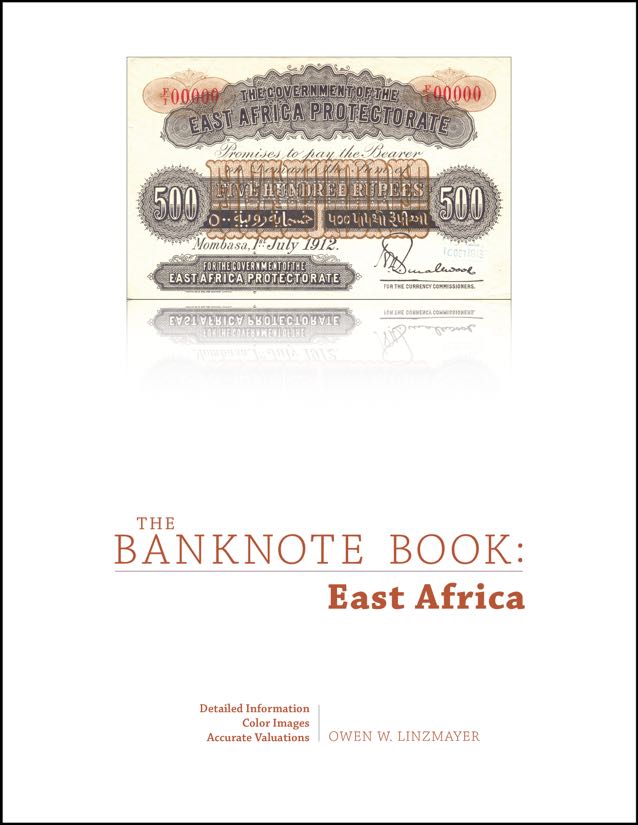
The East Africa chapter of The Banknote Book is now available for individual sale and as a free download to subscribers.
This 22-page catalog covers notes issued by the Government of the East Africa Protectorate from 1905 to 1919 and the East African Currency Board from 1920 to 1965. Revised 21 June 2016.
Each chapter of The Banknote Book includes detailed descriptions and background information, full-color images, and accurate valuations. The Banknote Book also features:
- Sharp color images of note’s front and back without overlap
- Face value or date of demonetization if no longer legal tender
- Specific identification of all vignette elements
- Security features described in full
- Printer imprint reproduced exactly as on note
- Each date/signature variety assigned an individual letter
- Variety checkboxes for tracking your collection and want list
- Date reproduced exactly as on note
- Precise date of introduction noted when known
- Replacement note information
- Signature tables, often with names and terms of service
- Background information for historical and cultural context
- Details magnified to distinguish between note varieties
- Bibliographic sources listed for further research
Subscribe to The Banknote Book
If you collect the entire world or a large number of countries, buying a subscription is the best deal because it's less expensive than buying chapters individually, and it entitles you to every chapter currently available as well as everything published—or revised (click here to see the Change Log)—during the term of your subscription.

Sign up for Email Notifications
If you would like to receive email notifications whenever a new chapter of The Banknote Book is published, please join the email list by clicking the button below.

Kenya to unveil new notes for issue in February 2015
20 08, 2013 18:15 Category: Africa
According to an article on allAfrica dated 19 August 2013, this week the government of Kenya may unveil a new set of Kenya banknotes that will be in circulation by February 2015. Secretary to the Cabinet Francis Kimemia said the new 10-, 20-, 50-, 100-, and 1,000-shilling notes will depict Kenyan tourism, economic engagement, wildlife, history, traditions, and cultures.
Courtesy of Andrew Roberts.
Courtesy of Andrew Roberts.
Kenya new signature variety 200- and 500-shilling notes dated 01.07.2001 confirmed
13 01, 2013 10:20 Category: Africa
200 shillings, 1st JULY 2001. Like CBK B35, but governor's signature is 23.25-mm wide, not 17.25-mm wide.
500 shillings, 1st JULY 2001. Like CBK B36, but governor's signature is 23.25-mm wide, not 17.25-mm wide.
All other denominations dated 1st JULY 2001 have been confirmed with 17.25-mm wide signature.
Likewise, all other denominations bearing the next date, 1st JULY 2002, have been confirmed with 23.25-mm wide signature.
Courtesy of Hartmut Fraunhoffer (www.banknoten.de).
500 shillings, 1st JULY 2001. Like CBK B36, but governor's signature is 23.25-mm wide, not 17.25-mm wide.
All other denominations dated 1st JULY 2001 have been confirmed with 17.25-mm wide signature.
Likewise, all other denominations bearing the next date, 1st JULY 2002, have been confirmed with 23.25-mm wide signature.
Courtesy of Hartmut Fraunhoffer (www.banknoten.de).
Kenya and De La Rue's currency partnership
15 04, 2012 09:39 Category: Africa
AllAfrica has an excellent article dated 13 April 2012 concerning the history of De La Rue's contracts to print banknotes for the Central Bank of Kenya.
Kenya seeks new note designs without portraits
08 03, 2012 10:23 Category: Africa
According to an article in The Star dated 8 March 2012 and an article in the Daily Nation dated 7 March 2012, the Central Bank of Kenya “hereby invites individuals, institutions, institutions, organizations and professional bodies to present in writing, proposals on elements/features to be considered for incorporation in the design of the proposed new Kenyan currency banknotes and coins.” Per Article 231(4) of the constitution, the new notes may not bear the portrait of any individual. All notes in Kenya currently feature a portrait of former president Jomo Kenyatta.
The issuance of new notes is at least two years away, and even after their introduction, existing notes will likely circulate in parallel until they wear out. The bank has not ruled out changes to the colors or sizes of the new notes, and has said that “dominant Kenyan physical features, flora and fauna and key economic activities such as agriculture, tourism and manufacturing, are expected to replace these presidential portraits.”
Courtesy of Thomas Krause.
The issuance of new notes is at least two years away, and even after their introduction, existing notes will likely circulate in parallel until they wear out. The bank has not ruled out changes to the colors or sizes of the new notes, and has said that “dominant Kenyan physical features, flora and fauna and key economic activities such as agriculture, tourism and manufacturing, are expected to replace these presidential portraits.”
Courtesy of Thomas Krause.
Kenya chapter of The Banknote Book is now available
24 06, 2011 16:55 Category: The Banknote Book | Africa
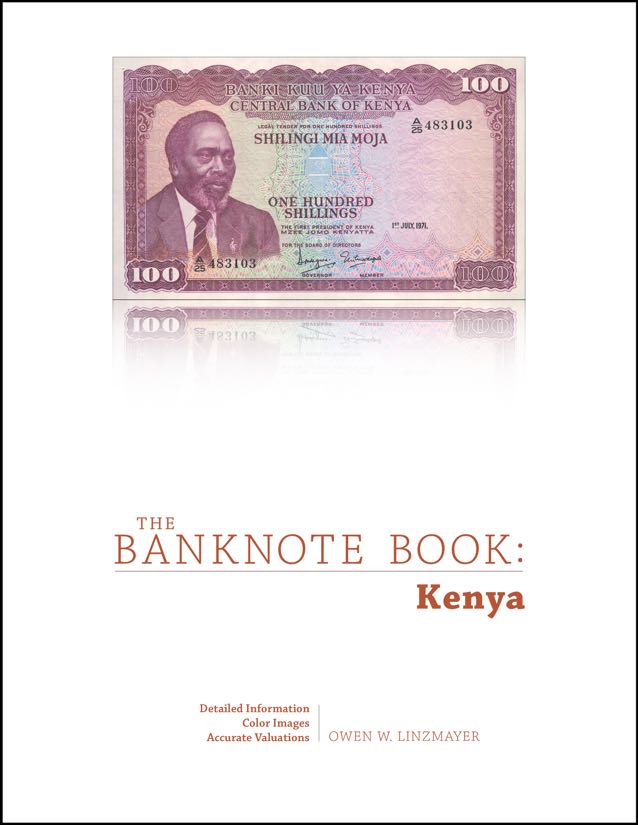
The Kenya chapter of The Banknote Book is now available for individual sale and as a free download to subscribers.
This 22-page catalog covers notes issued by the Central Bank of Kenya from 1966 to present. Revised 24 July 2016.
Each chapter of The Banknote Book includes detailed descriptions and background information, full-color images, and accurate valuations. The Banknote Book also features:
- Sharp color images of note’s front and back without overlap
- Face value or date of demonetization if no longer legal tender
- Specific identification of all vignette elements
- Security features described in full
- Printer imprint reproduced exactly as on note
- Each date/signature variety assigned an individual letter
- Variety checkboxes for tracking your collection and want list
- Date reproduced exactly as on note
- Precise date of introduction noted when known
- Replacement note information
- Signature tables, often with names and terms of service
- Background information for historical and cultural context
- Details magnified to distinguish between note varieties
- Bibliographic sources listed for further research
Subscribe to The Banknote Book
If you collect the entire world or a large number of countries, buying a subscription is the best deal because it's less expensive than buying chapters individually, and it entitles you to every chapter currently available as well as everything published—or revised (click here to see the Change Log)—during the term of your subscription.

Sign up for Email Notifications
If you would like to receive email notifications whenever a new chapter of The Banknote Book is published, please join the email list.

Kenya's constitution requires new notes without names
03 04, 2011 13:44 Category: Africa
According to an article in The East African dated 4 April 2011, Kenya's new constitution requires that names of individuals be removed from the front of banknotes and coins. The country's current notes, originally issued in 2004, all feature a named portrait of Kenya's first president, Mzee Jomo Kenyatta. This design is owned by De La Rue, which holds the exclusive contract for printing Kenya's banknotes. By changing the design to conform with the constitution, the Central Bank of Kenya would own the copyright on the new notes and could put their printing out to bid by other security printers. However, in a related article dated 4 April 2011, it's reported that DLR is on the verge of signing a new 10-year deal with the Central Bank of Kenya.
East African Community moves to introduce common currency in 2012
15 02, 2011 09:31 Category: Africa
An East African Business Week article dated 14 February 2011, contains interesting information on the continuing plans to form an East African Community Monetary Union similar to the European Union, wherein all the partner states will replace their individual currencies—the Burundian franc, Kenyan shilling, Rwandan franc, Tanzanian shilling, and Ugandan shilling—for a single regional currency in 2012.
Courtesy of Aidan Work.
Courtesy of Aidan Work.
Kenya new sig/date (16.07.2010) notes confirmed
14 01, 2012 20:03 Category: Africa

All six denominations (50 to 1,000 shillings) have been confirmed dated 16th JULY 2010 and bearing new signatures (Njuguna S. Ndung’u and unknown).
Courtesy of Richard Miranda, John B. Silver, Andrew Roberts, and Bill Stubkjaer.
Kenya new date (17.06.2009) shilling notes confirmed
14 05, 2010 07:08 Category: Africa
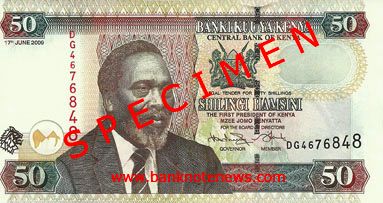

50 shillings (US$0.65), 17th JUNE 2009. Like Pick 41, but new date.

100 shillings (US$1.25), 17th JUNE 2009. Like Pick 42, but new date.
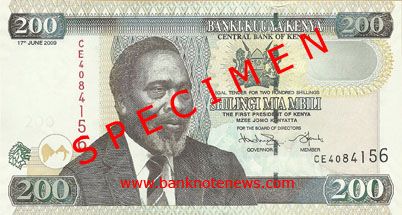
200 shillings (US$2.55), 17th JUNE 2009. Like Pick 43, but new date.

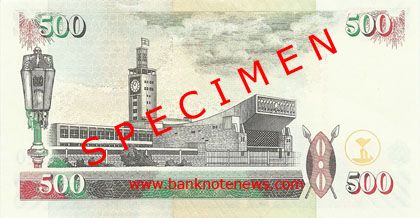
500 shillings (US$6.40), 17th JUNE 2009. Like Pick 44, but new date.
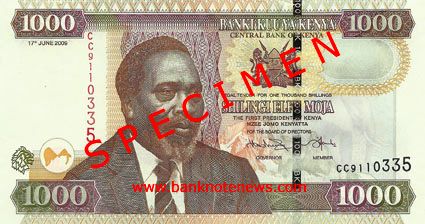
1,000 shillings ($12.80), 17th JUNE 2009. Like Pick 45, but new date.
Courtesy of John Silver.
Kenya banknotes may exclude portraits
25 11, 2009 09:45 Category: Africa
According to a Daily Nation article dated 18 November 2009, Kenya’s coins and notes will not bear the portrait of any individual if the proposals in the new draft constitution of Kenya are adopted. The draft proposes "Notes and coins issued by the Central Bank of Kenya may bear images that depict or symbolise Kenya or an aspect of Kenya but may bear the portrait of any individual." This means that former presidents Jomo Kenyatta and Daniel Moi will be the only personalities to have had portraits on Kenya’s currency.
Kenyans have a month to make their contributions on what they think of the proposals before changes are made to the draft constitution. A referendum is scheduled for early March 2010. If the referendum agrees to adopt the constitution, it will see the Central Bank governor hold office for a term of six years instead of the current four years, and will no longer be eligible for re-appointment.
Courtesy of Aidan Work.
Kenyans have a month to make their contributions on what they think of the proposals before changes are made to the draft constitution. A referendum is scheduled for early March 2010. If the referendum agrees to adopt the constitution, it will see the Central Bank governor hold office for a term of six years instead of the current four years, and will no longer be eligible for re-appointment.
Courtesy of Aidan Work.
The Challenge: Identify items on Kenyan notes
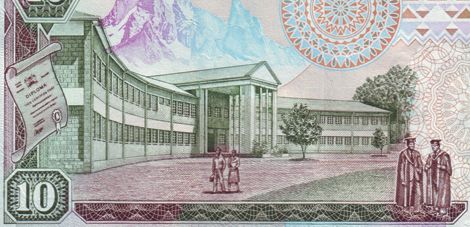
Can someone please identify the building on the back of Pick 24? Given the diploma and students in the vignette, it’s almost certainly a university, but which one? Educated guesses are welcome, but I am looking for definitive answers supported by citations if possible.
IDENTIFIED: Kabarnet Boys High School administration building in Baringo County.
Courtesy of Dennis Mukuba,
Kenya issues new date varieties (03.03.2008)
27 11, 2008 16:45 Category: Africa
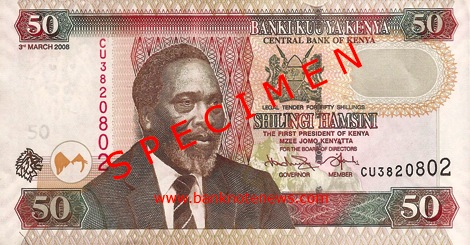
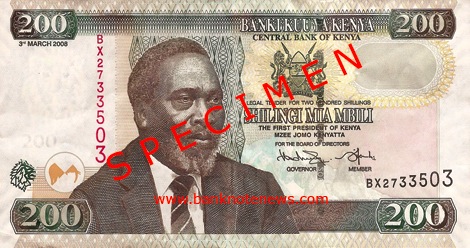
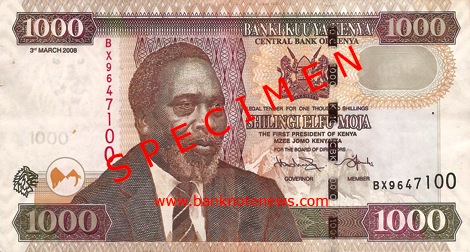
New 50-, 100-, 200-, 500- and 1,000-shilingi notes dated 3rd MARCH 2008 have been confirmed.
On 4 March 2007, Prof. Njuguna S. Ndung’u assumed the role of governor of the Central Bank of Kenya, and it is his signature which appears on these new notes.
Courtesy of John Silver.
Kenya date varieties confirmed / new signatures expected
27 10, 2007 09:38 Category: Africa
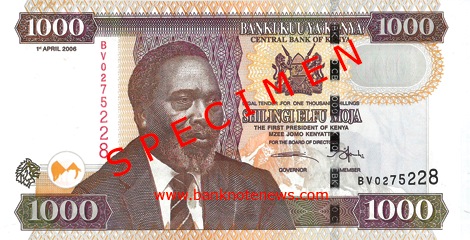
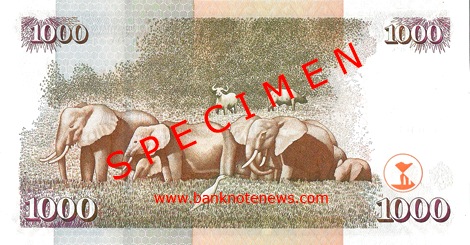
The Central Bank of Kenya has issued all denominations with dates of 1st APRIL 2006 and bearing the signature of the bank’s former governor, Andrew K. Mullei.
On March 4, 2007, Prof. Njuguna S. Ndung’j assumed the role of governor, so expect new signature varieties to surface as soon as old note stocks are depleted.
Courtesy of Andrew Roberts.
Kenya new varieties of 50-shilling note confirmed
11 11, 2006 10:25 Category: Africa
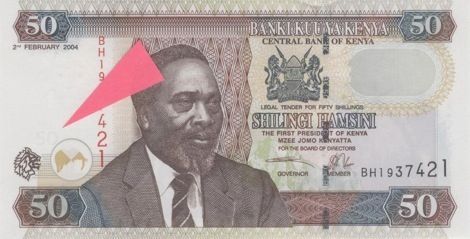
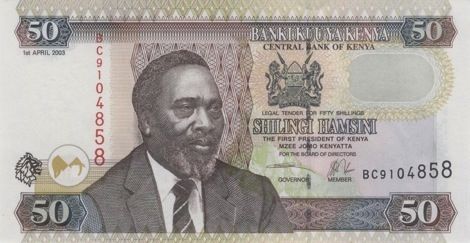
The most recent Standard Catalog of World Paper Money, Volume III, 12th edition, lists four dates of Kenya’s 50 shilling-note as Pick 41a. However, significant differences have been discovered in this and other recent denominations from Kenya.
The note dated 2nd February 2004 (above, top) has a windowed security thread that is wider than the one on the note dated 1st April 2003 (above, bottom), and this thread appears further to the right. Furthermore, the 2nd February 2004 note also has the denomination “50” visible in the watermark area under normal reflected light. This electrotype watermark appears on all subsequent date varieties (2nd August 2004, 1st June 2005, and 1st April 2006), all of which have a signature combination that differs from that which appears on the first two date varieties (the Governor is the same; only the Member signatory differs).
It has been reported that all Kenyan notes from 2004 onwards have the denomination as electrotype watermarks. It is also reported that all Kenyan notes from 2005 onwards have watermarks of stripes in all four corners. If confirmed, De La Rue is the likely printer because Cornerstone watermarks are a DLR trademark.
Malawi’s 20- and 200-kwacha notes dated 2004 were given new Pick numbers due to the addition of the denomination to the watermark. If the same standard applies to Kenya, the notes dated 2004 onwards deserve their own Pick numbers, too.
Courtesy of Jose Manuel Peso (IBNS member 8180).

